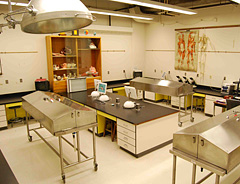
| A Mississippi medical school has come up with a new application for BAPI’s Volatile Organic Compound (VOC) sensor. They’re using it to ensure good air quality inside their cadaver laboratory. The human cadavers at the William Carey University lab are stored in a formaldehyde bath inside metal cabinets. Formaldehyde fumes are released into the air when the sealed cabinets are open, so the University wanted to increase the ventilation during those times to improve the air quality for students and staff. The BAPI VOC sensor was a perfect fit for the job because formaldehyde is one of the many volatile organic compounds that the sensor detects. As the formaldehyde levels build up in the lab, the VOC sensor allows them to be ventilated away by the HVAC system.
The lab is an integral part of the University’s Osteopathic Medicine program which was established in 2008 to address the severe shortage of primary care physicians in Mississippi and bordering states, particularly within rural and under-served communities. Osteopathic medicine is focused on treating the body by improving its natural functions rather than using medications, and the musculoskeletal system is a key element in maintaining health. Therefore the program includes extensive study in bones, muscles and cartilage — thus the need for cadaver lab. The university graduated its first class of Doctors of Osteopathic Medicine this year. Applications Growing for Versatile SensorThe VOC sensor used at the cadaver lab was originally designed by BAPI as a direct replacement for a CO2 sensor in demand-controlled ventilation. It detects human-generated VOCs as they build up in a room, indicating when more ventilation is needed, just like a CO2 sensor does. But it also detects contaminants from other sources such as building materials, cleaners, perfumes, furniture, equipment and carpet off-gassing. These are the types of contaminants that can adversely affect human health and productivity and yet they are invisible to a CO2 sensor. Although it was designed as a replacement for a CO2 sensor, a growing number of facilities with specific substance concerns — such as the university — are finding that the VOC sensor is the solution. Besides the cadaver lab, the sensor has proven effective in indoor swimming pools, welding plants, and gyms and exercise centers. It has even been used to tell when the outside air has high levels of automobile exhaust or forest fire smoke. The list of possibilities for this unique sensor is nearly endless. by Terry Noble, |
|




